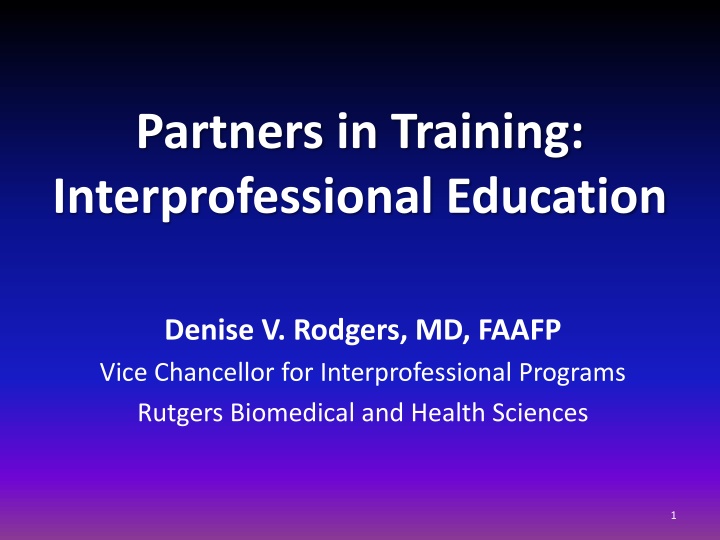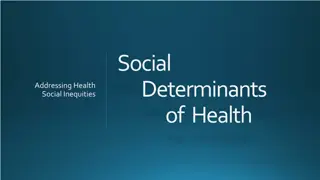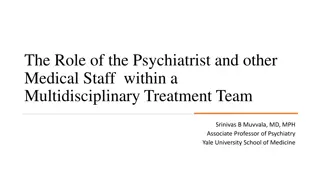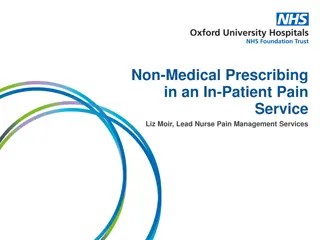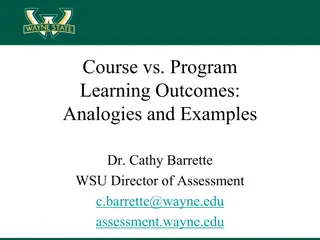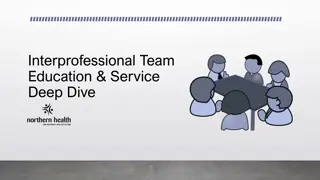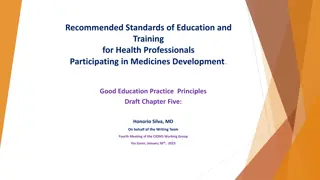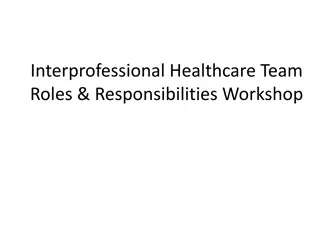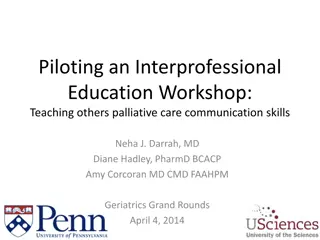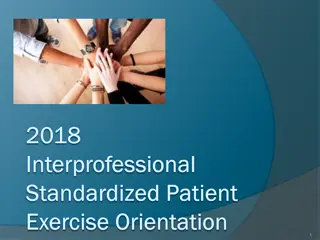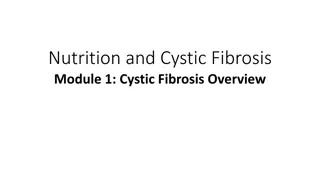Enhancing Health Outcomes Through Interprofessional Education
Interprofessional education fosters collaboration among healthcare professionals to improve patient outcomes. It involves shared learning between different professions, promoting integrated care solutions. Embracing interprofessionality requires a shift in values and ways of working, emphasizing continuous interaction and knowledge sharing. This approach enhances the quality and efficiency of healthcare delivery, ultimately benefiting patients, families, and communities.
Uploaded on Mar 21, 2025 | 2 Views
Download Presentation

Please find below an Image/Link to download the presentation.
The content on the website is provided AS IS for your information and personal use only. It may not be sold, licensed, or shared on other websites without obtaining consent from the author.If you encounter any issues during the download, it is possible that the publisher has removed the file from their server.
You are allowed to download the files provided on this website for personal or commercial use, subject to the condition that they are used lawfully. All files are the property of their respective owners.
The content on the website is provided AS IS for your information and personal use only. It may not be sold, licensed, or shared on other websites without obtaining consent from the author.
E N D
Presentation Transcript
Partners in Training: Interprofessional Education Denise V. Rodgers, MD, FAAFP Vice Chancellor for Interprofessional Programs Rutgers Biomedical and Health Sciences 1
WHO IPE Definition Interprofessional education occurs when students from two or more professions learn about, from and with each other to enable effective collaboration and improve health outcomes. WHO 2010 2
WHO IP Collaborative Practice Definition When multiple health workers from different professional backgrounds work together with patients, families, carers [sic], and communities to deliver the highest quality of care WHO 2010 3
Definition of interprofessionality the process by which professionals reflect on and develop ways of practicing that provides an integrated and cohesive answer to the needs of the client/family/population [I]t involves continuous interaction and knowledge sharing between professionals, organized to solve or explore a variety of education and care issues all while seeking to optimize the patient s participation Interprofessionality requires a paradigm shift, since interprofessional practice has unique characteristics in terms of values, codes of conduct, and ways of working. These characteristics must be elucidated D AmourD, Oandasan I. J Interprof Care. 2005 May;19 Suppl 1:8-20 4
HEALTHCARE AND BASKETBALL Thanks to Larry Mauksch, PhD 5
Highly Functioning Interprofessional Teams Improve Health Outcomes! 6
AND WE NEED ALL THE IMPROVEMENT WE CAN GET!!!! 7
IHI 100,000 Lives Campaign Six Interventions Deployment of Rapid Response Teams Delivery of Reliable, Evidence-Based Care for Acute Myocardial Infarction Prevention of Adverse Drug Events (ADEs) April 2006 ACP Guide for Hospitalists 8
IHI 100,000 Lives Campaign Six Interventions Prevention of Central Line Infections Prevention of Surgical Site Infections Prevention of Ventilator-Associated Pneumonia April 2006 ACP Guide for Hospitalists 9
IHI 100,000 Lives Campaign Deployment of Rapid Response Teams Who will comprise the Rapid Response Team? Our experience shows that multiple models work well, including the following: ICU RN, RT, Intensivist or Hospitalist ICU RN and Respiratory Therapist (RT) ICU RN, RT, Intensivist, Resident ICU RN, RT, Physician Assistant ED or ICU RN IHI How-to Guide: Rapid Response Team www.ihi.org 10
IHI 100,000 Lives Campaign Deployment of Rapid Response Teams Select each member (physician, RN, RT) of the Rapid Response Team carefully. The physician team member should be one who is respected by both nurses and physicians and perceived as a good communicator and team player. IHI How-to Guide: Rapid Response Team www.ihi.org 11
IHI 100,000 Lives Campaign Deployment of Rapid Response Teams In every model, there are four key features of Rapid Response Team members: The team members must be available to respond immediately when called. They must be onsite and accessible. They must have the critical care skills necessary to assess and respond. They must respond to every call with a smile on their face and a script that may include, Thank you for calling. How can I help you? IHI How-to Guide: Rapid Response Team www.ihi.org 12
IHI Triple Aim Improving Population Health Improving the Patient Experience of Care Reducing Per Capita Cost IHI Guide to Measuring Triple Aim White Paper www.ihi.org 13
IHI Triple Aim Key Measurement Principles Need a Defined Population Need to Track Data Over Time Must Distinguish Between Outcome and Process Measures IHI Guide to Measuring Triple Aim White Paper www.ihi.org 14
IHI Triple Aim Key Measurement Principles Must Distinguish Between Population and Project Measures Need to Identify Benchmark or Comparison Data to Measure Progress Against IHI Guide to Measuring Triple Aim White Paper www.ihi.org 15
IHI Triple Aim Population Health Outcome Measures Life Expectancy Years of Potential Life Lost Health and Functional Status IHI Guide to Measuring Triple Aim White Paper www.ihi.org 16
IHI Triple Aim Population Health Outcome Measures Healthy Life Expectancy Disease Burden Behavioral Factors (Smoking, Exercise, Diet) Physiological Factors (BP, BMI, Chol, Glucose) IHI Guide to Measuring Triple Aim White Paper www.ihi.org 17
IHI Triple Aim Experience of Care Outcome Measures Patient Surveys Consumer Assessment of Healthcare Providers and Systems (CAHPS) How s Your Health Surveys Likelihood to Recommend Surveys IHI Guide to Measuring Triple Aim White Paper www.ihi.org 18
IHI Triple Aim Per Capita Cost Measures Total Cost per Member of the Population per Month Hospital and Emergency Department Utilization Rate and/or Cost IHI Guide to Measuring Triple Aim White Paper www.ihi.org 19
WE BELIEVE THAT HIGHLY EFFECTIVE INTERPROFESSIONAL EDUCATIONAL EXPERIENCES ARE THE MOST EFFECTIVE WAY OF TRAINING HEALTH PROFESSIONS STUDENTS TO WORK AS MEMBERS OF INTERPROFESSIONAL TEAMS 20
Core Competencies for Interprofessional Collaborative Practice Interprofessional Education Collaborative Report May 2011 21
Core Competencies for Interprofessional Collaborative Practice 1: Values/Ethics for Interprofessional Practice 2: Roles/Responsibilities 3: Interprofessional Communication 4: Teams and Teamwork Interprofessional Education Collaborative Report May 2011 22
Core Competencies for Interprofessional Collaborative Practice 1: Values/Ethics for Interprofessional Practice These values and ethics are patient centered with a community/population orientation, grounded in a sense of shared purpose to support the common good in health care, and reflect a shared commitment to creating safer, more efficient, and more effective systems of care. They build on a separate, profession-specific, core competency in patient-centeredness. Interprofessional Education Collaborative Report May 2011 23
Core Competencies for Interprofessional Collaborative Practice 2: Roles/Responsibilities Learning to be interprofessional requires an understanding of how professional roles and responsibilities complement each other in patient-centered and community/population oriented care. Interprofessional Education Collaborative Report May 2011 24
Core Competencies for Interprofessional Collaborative Practice 3: Interprofessional Communication Communication competencies help professionals prepare for collaborative practice. Communicating a readiness to work together initiates an effective interprofessional collaboration Interprofessional Education Collaborative Report May 2011 25
Core Competencies for Interprofessional Collaborative Practice 4: Teams and Teamwork Teamwork behaviors involve cooperating in the patient-centered delivery of care; coordinating one s care with other health professionals so that gaps, redundancies, and errors are avoided; and collaborating with others through shared problem-solving and shared decision making, especially in circumstances of uncertainty . Interprofessional Education Collaborative Report May 2011 26
The Four Pillars for Primary Care Physician Workforce Reform: A Blueprint for Future Activity www.annfammed.org Vol. 12. no.1 83-87 27
The Four Pillars for Primary Care Physician Workforce Reform: A Blueprint for Future Activity Pipeline Process of Medical Education Practice Transformation Payment Reform www.annfammed.org Vol. 12. no.1 83-87 28
The Four Pillars for Primary Care Physician Workforce Reform: A Blueprint for Future Activity Pipeline Process of Medical Education Integration with Interdisciplinary Professional Education Practice Transformation Payment Reform www.annfammed.org Vol. 12. no.1 83-87 29
The Four Pillars for Primary Care Physician Workforce Reform: A Blueprint for Future Activity Practice Transformation Practice teams must include generalist physician leaders who serve as role models and deliver comprehensive, broad-scope primary care. Learners are part of interprofessional practice teams Learners will be exposed to the continuous care of patients in multiple settings, including ambulatory, inpatient, extended and home care. www.annfammed.org Vol. 12. no.1 83-87 30
Reconfiguring the Bedside Care Team of the Future The American Hospital Association Roundtable Discussion Released November 2013 http://www.aha.org/content/13/beds-whitepapergen.pdf 31
Hospitals will be used for acute disease management, procedural intervention and post-interventional care, and/or when a failure in and/or incapacity in other care settings occurs. http://www.aha.org/content/13/beds- whitepapergen.pdf 32
acute care is no longer the central hub of care with discharge into the community but, rather, realize that community-based and/or rehab alternatives will be the central and coordinating settings managing care to, and out of, the hospital. http://www.aha.org/content/13/beds- whitepapergen.pdf 33
Led by multi-disciplinary licensed professionals with an intensivist orientation, routine patient care will likely be delegated to more intensivist-oriented and specifically trained non-licensed staff. http://www.aha.org/content/13/beds- whitepapergen.pdf 34
Some teams may be physician-led, with nurses, physical therapists and a social worker at the core; others may be led by nurses, therapists and a nutritionist, with a physician in a less prominent role. http://www.aha.org/content/13/beds- whitepapergen.pdf 35
Care is co-created and shared not only by the bedside care team, but with an engaged patient/family to uphold and share responsibility for care plan compliance. (A role for the primary care provider/team seems to be completely absent here!) http://www.aha.org/content/13/beds- whitepapergen.pdf 36
SOME OF MY QUESTIONS WHAT ARE OUR STUDENTS AND RESIDENTS CURRENTLY LEARNING ABOUT INTERPROFESSIONAL TEAM WORK? WHAT ARE THE ATTITUDES OF FAMILY MEDICINE FACULTY ABOUT INTERPROFESSIONAL EDUCATION AND PRACTICE? WHERE IS HIGHLY EFFECTIVE INTERPROFESSIONAL CARE BEING PROVIDED IN FAMILY MEDICINE DEPARTMENTS? WHERE IS HIGHLY EFFECTIVE INTERPROFESSIONAL EDUCATION BEING PROVIDED IN FAMILY MEDICINE DEPARTMENTS? 37
SOME OF MY QUESTIONS HOW MUCH, AND WHAT TYPES OF INTERPROFESSIONAL LEARNING EXPERIENCES DO STUDENTS NEED? HOW DO WE MEASURE COMPETENCE IN INTERPROFESSIONAL TEAMWORK? HOW DO WE IMPROVE PROFESSIONALISM AND CIVILITY IN THE CLINICAL ENVIRONMENT? SHOULD WE MORE OVERTLY EVALUATE FACULTY, RESIDENTS, AND STUDENTS ON THEIR ABILITY TO PRODUCTIVELY WORK AS MEMBERS OF INTERPROFESSIONAL TEAMS? 38
SOME OF MY QUESTIONS HOW DO WE DEVELOP MEASURES TO EVALUATE STUDENTS AND RESIDENT SKILLS IN INTERPROFESSIONAL TEAM WORK? ARE WE TRAINING FAMILY MEDICINE RESIDENTS TO BE INTERPROFESSIONAL TEAM LEADERS? HOW DO WE DEAL WITH TEAM MEMBERS WHO DON T BEHAVE PROFESSIONALLY? HOW DO WE DEAL WITH TEAM MEMBERS WHOSE FUND OF KNOWLEDGE MAY BE INADEQUATE? 39
SOME OF MY QUESTIONS HOW DO WE BEGIN TO IDENTIFY OVERLAPS IN PRACTICE AND DISTINGUISHING SKILL SETS BETWEEN PROFESSIONS? IF THE GOAL IS TO PRACTICE AT THE HIGHEST LEVEL OF SCOPE OF PRACTICE WILL FAMILY PHYSICIANS MISS OUT ON ALL THE FUN STUFF AS THEY CARE FOR ONLY THE MOST CHALLENGING PATIENTS? WHAT PERCENTAGE OF THE KNOWLEDGE AND SKILLS OF A FAMILY PHYSICIAN OVERLAP WITH THE KNOWLEDGE AND SKILLS OF A FAMILY NURSE PRACTITIONER OR A PRIMARY CARE PHYSICIAN ASSISTANT? SHOULD PATIENTS KNOW THE DIFFERENCE BETWEEN A DOCTOR WHO IS A PHYSICIAN AND A DOCTOR WHO IS A NURSE? 40
Your Thoughts and Questions 41
